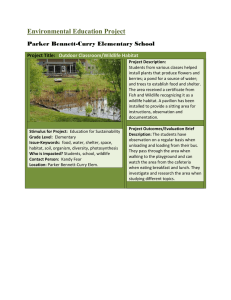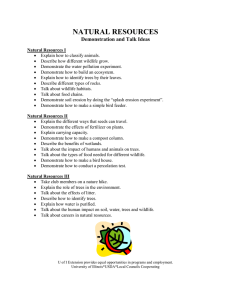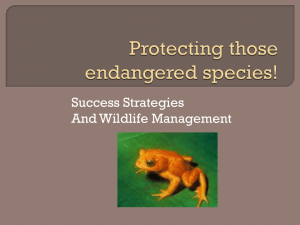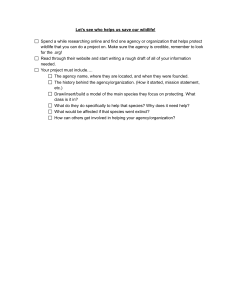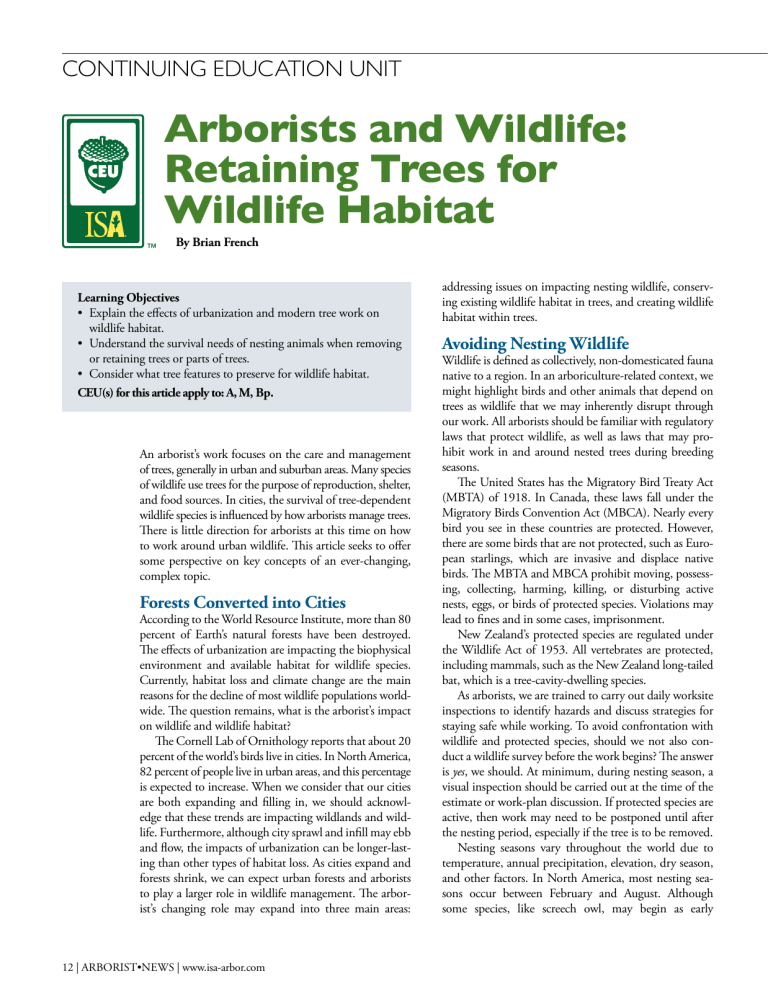
continuing education unit Arborists and Wildlife: Retaining Trees for Wildlife Habitat By Brian French Learning Objectives • Explain the effects of urbanization and modern tree work on wildlife habitat. • Understand the survival needs of nesting animals when removing or retaining trees or parts of trees. • Consider what tree features to preserve for wildlife habitat. CEU(s) for this article apply to: A, M, Bp. An arborist’s work focuses on the care and management of trees, generally in urban and suburban areas. Many species of wildlife use trees for the purpose of reproduction, shelter, and food sources. In cities, the survival of tree-dependent wildlife species is influenced by how arborists manage trees. There is little direction for arborists at this time on how to work around urban wildlife. This article seeks to offer some perspective on key concepts of an ever-changing, complex topic. Forests Converted into Cities According to the World Resource Institute, more than 80 percent of Earth’s natural forests have been destroyed. The effects of urbanization are impacting the biophysical environment and available habitat for wildlife species. Currently, habitat loss and climate change are the main reasons for the decline of most wildlife populations worldwide. The question remains, what is the arborist’s impact on wildlife and wildlife habitat? The Cornell Lab of Ornithology reports that about 20 percent of the world’s birds live in cities. In North America, 82 percent of people live in urban areas, and this percentage is expected to increase. When we consider that our cities are both expanding and filling in, we should acknowledge that these trends are impacting wildlands and wildlife. Furthermore, although city sprawl and infill may ebb and flow, the impacts of urbanization can be longer-lasting than other types of habitat loss. As cities expand and forests shrink, we can expect urban forests and arborists to play a larger role in wildlife management. The arborist’s changing role may expand into three main areas: 12 | Arborist•News | www.isa-arbor.com addressing issues on impacting nesting wildlife, conserving existing wildlife habitat in trees, and creating wildlife habitat within trees. Avoiding Nesting Wildlife Wildlife is defined as collectively, non-domesticated fauna native to a region. In an arboriculture-related context, we might highlight birds and other animals that depend on trees as wildlife that we may inherently disrupt through our work. All arborists should be familiar with regulatory laws that protect wildlife, as well as laws that may prohibit work in and around nested trees during breeding seasons. The United States has the Migratory Bird Treaty Act (MBTA) of 1918. In Canada, these laws fall under the Migratory Birds Convention Act (MBCA). Nearly every bird you see in these countries are protected. However, there are some birds that are not protected, such as European starlings, which are invasive and displace native birds. The MBTA and MBCA prohibit moving, possessing, collecting, harming, killing, or disturbing active nests, eggs, or birds of protected species. Violations may lead to fines and in some cases, imprisonment. New Zealand’s protected species are regulated under the Wildlife Act of 1953. All vertebrates are protected, including mammals, such as the New Zealand long-tailed bat, which is a tree-cavity-dwelling species. As arborists, we are trained to carry out daily worksite inspections to identify hazards and discuss strategies for staying safe while working. To avoid confrontation with wildlife and protected species, should we not also conduct a wildlife survey before the work begins? The answer is yes, we should. At minimum, during nesting season, a visual inspection should be carried out at the time of the estimate or work-plan discussion. If protected species are active, then work may need to be postponed until after the nesting period, especially if the tree is to be removed. Nesting seasons vary throughout the world due to temperature, annual precipitation, elevation, dry season, and other factors. In North America, most nesting seasons occur between February and August. Although some species, like screech owl, may begin as early as January in the Pacific Northwest region. Peak nesting season is the most critical time of the year in the Pacific Northwest, and is found between May and July. Knowing when the nesting season begins and ends in your region is prudent to avoid conflict on the job site. Imagine having to stop work in April, postpone, and then reschedule for August, because the project planner or estimator was unaware of such federal laws. Another consideration is knowing where birds prefer to build their nests. Birds such as kestrel, nuthatch, and swifts are cavity-dwelling species that live inside trees. Whereas geese, killdeer, grouse, and savanna sparrow nest on the ground. Nesting behavior can be divided into the following groups: tree-nesting, ground-nesting, groundcavity nesting, shrub-nesting, standing-snag nesting, and cut-bank nesting. No matter what type of nest a species prefers, if the species is protected, there is exposure of an arborist to liability while they perform their work. Not destroying active nests is everyone’s responsibility. As professional arborists, we can even take it a step further by implementing wildlife protocols into our businesses and training regimes to be cognizant of these things during work practices. Additionally, arborists can use resources, like a wildlife biologist, to conduct a survey for a large site, as well as an on-call wildlife rescue center, for when an active nest or injured animal is encountered. Many resources are available for training staff—like connecting with your local Audubon Society, wildlife departments or agencies, and wildlife care centers. Conserving Wildlife Habitat Trees There is no question that arborists should be considering what trees and parts of trees can be kept as wildlife habitat. But before considering what tree features to preserve, I think it is important to consider what types of wildlife could benefit most from arborists being focused on conserving wildlife habitat trees. One type in tree-dependent wildlife species that should stand out to arborists are those that dwell in tree cavities. These animals need the presence of decay, hollows, deadwood, and/or a snag, that is, a standing dead tree. The survivability for many of these wildlife species is determined by the existence of dead or dying trees. Among the several species critically dependent on tree cavities are wood duck, mandarin duck, pileated woodpecker, greathorned owl, kestrel, chickadee, clouded salamander, and flying squirrel. It is because of habitat loss from land conversion for agriculture, deforestation, and urban sprawl that many of these species continue to be threatened. For example, the Carolina parakeet was a cavity-dweller. In 1920, this bird was reported extinct by the International Union for Conservation Illustration of a nesting tree for cavity dwellers, which are animals that live inside trees. BRIAN FRENCH Cavity Dwellers of Nature; deforestation was a major contributor to this outcome. This bird, the only native parakeet to North America, was once found from the eastern seaboard to Colorado. Regardless of our intentions as arborists, we impact the survival of these animals when removing or retaining u continuing education unit trees or parts of trees. Our impacts can be positive, or, and sometimes without even knowing, negative. By identifying deadwood, cavities and hollows in a tree, recommending that tree’s removal, chipping it up, and removing it from the site, those arborists are partially responsible for the destruction of wildlife habitat in urban areas. Arborists have a unique opportunity to preserve, create, and restore habitat for wildlife. Sometimes, the best practice may be to identify a habitat’s value, and if possible, retain it. BRIAN FRENCH There is still much to be understood about the value of dead trees in our community. One consideration might be the detritivores and decaying organisms that are present during the process of decomposition in wood. Decaying organisms that cause heart rot in trees, create hollows. Woodpeckers use specialized sensory methods to locate this type of decay within trees, excavate the wood surrounding the decay, and make their homes in it. There are times when it’s more appropriate to remove deadwood, but can arborists find opportunities to retain it? According to Dr. Edward Gilman, author of An Illustrated Guide to Pruning (2002), there is no evidence at this time that supports the statement, “Removing deadwood improves tree health.” Valuing deadwood and dead trees have been emerging topics of debate in professional arboriculture for some time now. For example, the term “crown clean” has been removed from the ANSI A300 Standard’s section on pruning, as well as from 14 | Arborist•News | www.isa-arbor.com Downy woodpecker. Keep in mind the many features of habitat trees. BRIAN FRENCH Deadwood, Snags, and Wildlife Trees The Importance of Mature Trees Young tree structure cannot replace old tree structure in terms of habitat, no matter how many trees we plant. Another way to say this is that an infinite number of young trees cannot offer what one old tree can provide. Habitat features that increase with tree age may consist of greater structural complexity, an abundance of cavities, height gradient, elaborate root systems, and large deadwood and decaying substrate. Illustration of the structural development of a tree over time. Consider that an infinite number of young trees cannot offer what one old tree can provide, in terms of enduring habitat features. BRIAN FRENCH arboricultural Best Management Practices. The term, of course, refers to the removal of deadwood as non-beneficial parts of the tree, which is not true with regards to wildlife habitat and its vitality to dependent species. So, how do we value dead trees in urban areas? We can certainly find a correlation between the loss of deadwood as habitat and the populations of wildlife that depend on it. It is also true that there is far more wildlife living in the cycle of dead trees than of living trees. Is there a way to know when a habitat snag is safe? This is most often determined by factors such as the tree’s likelihood of failure, its height, and its distance from a target. We should remember that dead trees are still trees, and that the same systematic approach of tree risk assessment can be used. Are dead trees more likely to fall than live trees? Not necessarily. It is recommended that when we are creating or retaining deadwood for wildlife habitat, plans for return visits are implemented to monitor structural integrity. Snags can be broken up into several categories or stages of decomposition. Assessments of snags can be performed with various methods, such as pull-testing. One point to remember is that the range of species capable of using dead trees as habitat varies as the height of a snag changes. Not all snags left for habitat need to be tall. Some species, like nuthatch, house wren, and chickadee prefer nesting sites in snags as low as 5–15 feet (1.25–4.57 m). In this article, let’s also include epiphytes as wildlife flora that require specific tree structures and composition. For many forests, old trees that produce large branches offer adequate horizontal space for epiphytic communities to take hold, thrive, and provide an abundance of diverse life. Creating Wildlife Habitat Trees All living organisms have habitat preferences, from the bacteria in your stomach to the blue whale in the ocean. In nature, habitat preference is central to vitality. Cavity dwellers that live in trees are no different. Each species is conditioned for an ideal range of temperature, distance from food source, moisture, shelter, and protection from predators. Table 1, for example, is a cavity-preference table for oriental pied hornbill, an avian native to southeastern Asia. u continuing education unit Terminology Here are some pruning and saw-cutting technique terms, summarized for this article. Some terms are described or explored in further detail in the references provided. Bat kerf, bat slit: A very shallow, diagonal, upward cut, creating a slit-like crevice within the tree. This cut is to mimic bat habitat in trees. Many bats in North America use this habitat for day and night roosting (Brown 2002). Coronet cuts: A series of jagged cuts on a stub, made to mimic natural limb or stem failure. This technique is most often for used retrenchment pruning or at the top of wildlife snags (Fay 2003). Eagle, hawk, osprey platform: Fastening branches at the top of a wildlife snag (tree) to create a platform for nesting species such as osprey. Drilling and fastening with screws is a preferred method over string or wire to avoid birds getting tangled. Fracture pruning: Pruning techniques used to mimic the way that tears and fractured ends naturally occur on trunks and branches (Fay 2003). Fracture pruning (deadwood): Reducing the length of dead branches by breaking or cutting partially through; breaking and retaining dead stubs on a tree. Inset bat house: Bore-cutting and removing appropriate-sized face plate, creating a series of vertical kerfs within the tree’s stem with the center kerf extending lowest for the entrance hole. All internal bat slits should connect to the entrance whole opening. Then fastening the face plate with room for ingress (Brown 2002; Hjelm 2014). Inset or artificial cavity: A series of cuts, some bore cuts, first sectioning the face plate. Then an additional series of cuts to remove and expose the interior of the tree to mimic a natural cavity. Then fastening the face plate and adding an entrance hole that meets the species specifications (Brown 2002; Kenyon and Kenyon 2010). Lightning strike scarring: A series of vertical, contiguous cuts on a stem or trunk mimicking a lighting strike on a tree (Brown 2002; Kenyon and Kenyon 2010). BRIAN FRENCH Photos of inset-cavity techniques that meet habitat specifications for chickadee. This is a service I provide to many of my clients. During the summer, many bat species roost in the spaces behind loose bark. These spaces are occupied after a tree or tree part dies, begins to dry out, and the process of bark’s sloughing occurs. Similarly, bats will sometimes use steeply sloped, old shake roofs (if the entrance space is appropriate). Bats use these spaces for day and night roosting. Some bats, like little brown bats in the Pacific Northwest, rely on these habitat crevices near their source of prey, which mostly consists of mosquitoes, beetles, moths, flies, and gnats. Amazingly, bats can eat 600–1,000 mosquitoes 16 | Arborist•News | www.isa-arbor.com an hour, and up to 6,000 a night. The constant loss of habitat for bats has had a great impact on their populations. This is especially true in the urban, rural, and interface areas where most arborists work. An option for enhancing habitat snags for bats is to artificially create roosting sites with the use of a saw. Hollows for cavity-dwelling wildlife have been monitored and measured for decades, and in some cases, centuries. This information has offered arborists the ability to recognize and also create cavities specific for Table 1. A cavity-preference table for the oriental pied hornbill. This is the type of information that will be helpful for arborists interested in creating habitat trees for area wildlife. Cavity Height Depth/Width Above the orientation (cm) (cm) ground (m) Anthracoceros Vertical 100 45 1–6 albirostris each species. Specifications are made from criteria such as cavity dimensions, orientation, aspect, distance from water, height from ground, and use by primary or secondary excavator and potential predators, among other things. Arborists and foresters from the U.S., Canada, Australia, and the UK have been implementing practices using chain saws to create cavities and other types of habitat in trees for wildlife conservation. This is significant in that arborists are successfully using nearly the same methods to create habitat for unrelated wildlife species oceans apart. Conclusion I believe that someday arborists will offer services like wildlife habitat retention, enhancement, and creation as part of their regular services to the public. As an arborist, I make many decisions with wildlife in mind. Arborists have unique access to climb, study, and manage habitat in trees. Encountering opportunities around wildlife habitat are constant occurrences for arborists. These may be recognized by a tree’s size, age, architecture, condition, and environmental surroundings. Some opportunities may present themselves as trees that have experienced large failures and are now being considered for removal, lightning-struck trees, topped trees, suppressed trees, or invasive tree species. In general, it is good practice to be Entrance hole (oval-vertical) 20–25 cm (ht.) 10–15 cm (whh) Hole ht. above cavity floor 15 cm Hole entrance thickness 10 cm Preferred flora Dipterocarp aware of wildlife protection laws, to leave habitat alone, when possible, and to consider what season the work shall be conducted in. Finally, remember that your professional decisions are impacting wildlife. Additional Reading Brown, T.K. 2002. Creating and Maintaining Wildlife, Insect and Fish Habitat Structures in Deadwood. USDA Forest Service General Technical Report PSW-GTR-181 <www.fs.fed.us/psw/publications/ documents/gtr-181/067_Brown.pdf> Dunster, J.A. 1998. The role of arborists providing wildlife habitat and landscape linkages throughout the urban forest. Journal of Arboriculture 24(3). Fay, N. 2003. Natural Fracture Pruning Techniques and Coronet Cuts. Arbor Ecology <www.arborecology. co.uk/resources/coronetcuts_naturalfracture.pdf> Hjelm, F. 2014. Information sheet series. 01: Trees for Habitats. The Living Tree Company. <http:// thelivingtreecompany.co.nz/assets/Uploads/HabitatPDF.pdf> Kenyon, P., and P. Kenyon. 2010. Pruning for Habitat Workshops. Victorian Tree Industry Organisation (VTIO). TreeNet <www.treenet.org/resources/ pruning-for-habitat-workshop> In May 2017, I traveled to Borneo to present similar techniques for a bird I have since become fascinated with, the hornbill. There are over 60 species of hornbill that exist among forests in Africa and throughout southeastern Asia. All hornbills are cavity-dwelling, and several are threatened by extinction. The illustrations provided here are for the steps applied to produce an inset cavity for oriental pied hornbill, for Sarawak Forestry in Malaysia. BRIAN FRENCH Species u continuing education unit Brian French is a skilled climber with a broad range of arboriculture related experience and certifications, such as CA, CTW, and Tree Risk Assessor. He is an ISA Certified Arborist (#PN-2786A) practicing for over 18 years in Oregon and abroad. He is dedicated to, and a contributor of, cutting-edge research for a better understanding of trees and safer work practices for arborists worldwide. Visit his website (www.arboriculture.international/about-1). Acknowledgments. I would like to thank Ryan Gilpin for reviewing this article during its development. To complete this quiz, go online to the ISA webstore (www.isa-arbor.com/store), log into your personal account, and select “Online CEU Quizzes” on the store’s main page. If you need a username and password, send us an e-mail (isa@isa-arbor.com). If you require assistance in navigating the web interface, please view the online quiz tutorial. A passing score for this quiz, Arborists and Wildlife: Retaining Trees for Wildlife Habitat, requires sixteen correct answers. Quiz results will display immediately upon quiz completion. CEU(s) are processed immediately. You may take the quiz as often as is necessary to pass. CEU(s) for this article apply to: A, M, Bp. 1. According to the World Resource Institute, roughly what percentage of Earth’s natural forests have been destroyed? a. more than 80 percent b. less than 70 percent c. about 50 percent d. less than 50 percent 2. What is the approximate percentage of birds that live in cities? a. 15 percent b. 20 percent c. 30 percent d. 35 percent 3. All of the following are mentioned as regulatory laws that protect wildlife, except a. Migratory Bird Treaty Act of 1918 b. Wildlife Act of 1953 c. Avian Welfare Law of 1972 d. Migratory Birds Convention Act 4. Which of the following is not a cavity-dwelling species? a. kestrel b. nuthatch c. swift d. plover 5. Geese, killdeer, and savanna sparrow nest where? a. ground b. cut-bank c. standing-snag d. shrub 6. In North America, all nesting seasons occur between February and August. a. True b. False 7. If protected species are found nesting in a tree on which work is planned, which of the following is likely the best course of action? a. conduct work as planned, avoiding nests b. move the nest(s) clear of the work c. determine if hatchlings are present in the nest before beginning work d. consider postponing work until after the end of nesting season 8. Which of the following is not a type of nesting behavior mentioned in the article? a. ground-cavity nesting b. leaf-nesting c. shrub-nesting d. tree-nesting 18 | Arborist•News | www.isa-arbor.com 9. A habitat snag is defined as a a. horizontal or vertical space in a tree b. tree with delaminating bark c. standing dead tree d. tree with cavities 10. Which of the following birds is described as extinct, due to deforestation? a. Carolina parakeet b. killdeer c. American kestrel d. Carolina wren 11. Which of the following pruning terms, referring to the removal of deadwood as nonbeneficial, was removed from the recent revision of the ANSI A300 Standard? a. crown raise b. crown clean c. crown reduction d. heading 12. There is more wildlife living in the cycle of dead trees than of living trees. a. True b. False 13. Which of the following is an important consideration when creating or retaining deadwood for wildlife habitats? a. a systematic approach to tree risk assessment is not necessary b. plans for return visits to monitor structural integrity should be implemented c. recognizing that dead trees are more likely to fall than live trees d. none of the above 14. Species such as nuthatch, house wren, and chickadee prefer nesting sites in snags at a height of a. 1–3 feet (0.31–0.91 m) b. 5–15 feet (1.52–4.57 m) c. 18–20 feet (5.5–6.1 m) d. none of the above 15. Bats rely on which of the following tree habitats? a. bark flange b. bat slit c. bat slot d. all of the above 16. An inset cavity can also be thought of as an a. artificial cavity b. natural cavity c. slit cavity d. ectioned cavity 17. Relative to young trees, mature trees have which of the following habitat features that increase with age? a. structural complexity b. elaborate root systems c. cavity abundance d. all of the above 18. A series of jagged cuts made to mimic natural limb or stem failure is known as a. retrenchment cuts b. natural cuts c. coronet cuts d. thinning cuts 19. When creating a platform for nesting species in a tree, the preferred method for fastening the platform is with a. screws b. string c. wire d. all of the above 20. Before creating a tree cavity, which of the following information is important to gather about a wildlife species’ preferences? a. cavity orientation b. height from ground c. cavity depth d. all of the above Apply today for Student Awards and Grants for the ISA Annual International Conference and Trade Show Submission Deadline: 28 February 2018 To facilitate the professional development of future industry professionals, ISA encourages you to apply for the ISA Student Ambassador Program and the Arboricultural Research and Education Academy (AREA) Student Travel Grant to help students attend our conference. Student Ambassadors and AREA Grant winners will receive Join us in • Free conference registrations Columbus, Ohio! • Generous travel/hotel assistance 5–8 August 2018 • Networking opportunities with top industry professionals • Recognition as an integral part of the future of arboriculture For More Information and Online Application http://www.isa-arbor.com/events/conference/studentopportunities.aspx FEBRUARY 2018 | 19


